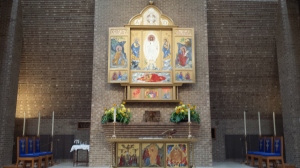Cast your burden upon the Lord, and he will sustain you; he will never let the righteous stumble. (Psalm 55:24. The Book of Common Prayer, p.662).
The words above spoke to me a couple of days ago during the Office of Diurnum (or Noonday Prayer).
The first part of the verse is beautifully sung in the well known Oratorio Elijah by Felix Mendelssohn. The melody suggests the freedom from the burden by casting it upon the Lord with complete trust in God’s ability to sustain us.
The second part, “he will never let the righteous stumble” really caught my attention. The Antiphon before this part of the Psalm is prayed read, “God will never let the righteous stumble.” After I read those words, I found myself praying about them in Lectio Divina. I have no reason to expect God to keep me from stumbling. I am a weak man with the capability to think only of myself and about myself. I can confess quite openly that I have those times in my life when I find myself caught between what God may want me to do, and what I want to do; only to choose my way with haste.
The answer to this prayer came by way of a book I am reading entitled, Life Together: The Classic Exploration of Christian Community by Dietrich Bonhoeffer. On page 48, Bonhoeffer writes,
“Can we, with the Psalmist, call ourselves innocent, devout, and righteous? We dare not do so in so far as we are ourselves. We cannot declare our virtue as the prayer of our own perverse heart. But we can and should do so as a prayer out of the heart of Jesus Christ that was sinless and clean, out of the innocence of Christ in which he has given us a share by faith. In so far as “Christ’s blood and righteousness” has become “our beauty, our glorious dress,” we can and we should pray the psalms of innocence as Christ’s prayer for us and gift to us. These Psalms, too, belong to us through him.”
In Chapter 19, The Discipline of the Psalmody, of The Rule of Saint Benedict, he wrote,
“We believe that the divine presence is everywhere and that in every place the eyes of the Lord are watching the good and the wicked (Prov. 15:3). But beyond the least doubt we should believe this to be especially true when we celebrate the divine office.” (RB 1980, p.47).
What is our point of contemplative prayer here?
God’s perspective of us is through the death and resurrection of Jesus Christ. It is because of this great mystery of our faith as Christians that we can depend on God not letting the righteousness that is ours through Christ stumble with no place else to turn. We can and should turn to the mercy of God in Christ so that the righteousness which we have gained through Christ Jesus becomes a living reality; even through our common faults. God seems to know very well what to do with those.
This seems to be one incredible moment of contemplative prayer.
What do you think?
Amen.
Br. Anselm Philip King-Lowe, n/OSB
